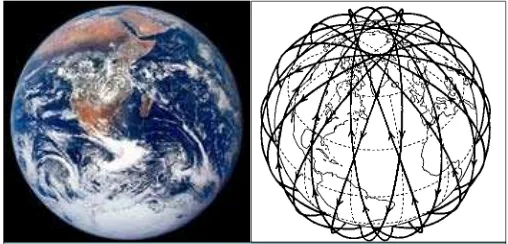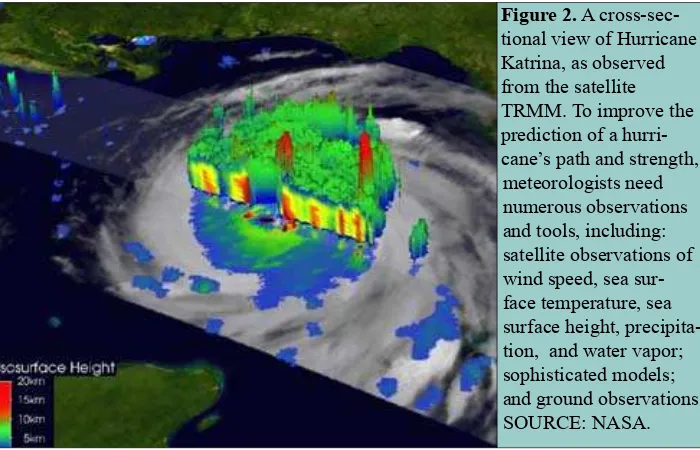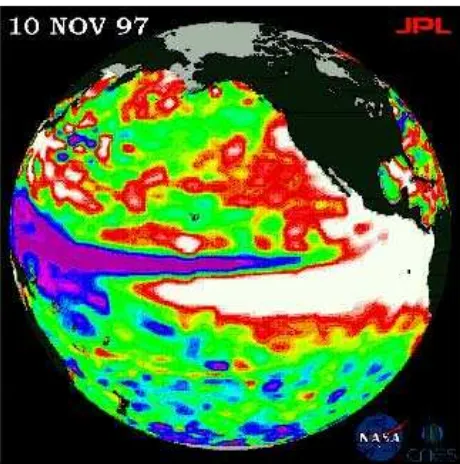Earth Observations from Space
The First 50 Years of Scientiic Achievements
Since the launch of Sputnik I in 1957, thousands of satellites have been sent into space on missions to collect data about the Earth. Today, the ability to forecast weather, cli-mate, and natural hazards depends critically on these satellite-based observations. Satellites have revolutionized how humans view and understand the home planet, helped address fun-damental scientiic questions, and enabled a plethora of applications with important societal beneits. Continued Earth observations from space will be required to address scientiic and societal challenges of the future.
W
here will a developing hurricane make landfall? What is the status of the ozone layer? How much will sea level rise? No other single measurement platform has revolutionized the ability to address these and other fundamental Earth science questions as much as satellites orbiting the Earth. From weather forecasting to high-tech navigation systems to answering fundamental questions about the Earth’s climate, satellites have become a crucial part of a wide variety of scientiic endeavors and practical applications over the past 50 years.The National Research Council convened a committee to examine the
sci-entiic accomplishments that have resulted from space-based satellite observations. This report concludes that the advent of satellite observa-tions has revolutionized the Earth research endeavor, and highlights examples of how such observations have led to new discoveries, opened new avenues of research, and provided important societal beneits by improving the predictability of Earth system processes. These scientiic achievements underscore the importance of satellite observa-tions and the need for a renewed commitment to Earth observations from space.
The Unique Value of Satellite
Observations
Observations from space over the past 50 years have fundamentally transformed the way people view the Earth. The image of the “blue marble” (Figure 1) is taken for granted now, but it was revolutionary when it was taken in 1972 by the crew on Apollo 17. Since then, the capability to look at Earth from space has grown increasingly sophisticated as space observations evolved from simple photographs to quantitative measurements of properties such as temperature, concentrations of atmo-spheric gases, and the exact elevation of land and ocean.
The global view from satellite observations is unmatched in its ability to resolve the dynamics and variability of Earth processes. Ship-based observa-tions, for example, cannot provide spatial coverage frequently enough to detect the dynamic nature of the ocean. Similarly, aircraft and weather balloon mea-surements alone cannot resolve the details required to understand the complex dynamics of ozone depletion. Satellite observations have not only transformed the Earth sciences—vastly more accurate global observations and consequently improved predictabil-ity of Earth processes also provide profound social beneits. From revolutionizing the ability to predict weather to enabling the development of the Global Positioning System, satellites have become essential to everyday applications that improve human safety and the quality of life.
Scientiic Accomplishments Resulting from
Satellite Observations
The report provides examples of how satellite observations have enabled Earth scientists to address fundamental questions ranging from atmospheric circulations and composition to the role of aerosols in climate, year-to-year variability in sea ice, the role of the ocean in climate change, and the convection of the Earth’s crust. Many of these scientiic advances have direct societal applications; a selection of these is described below.
Weather Imagery and Forecasting
Some of the most broadly used products from satellites are weather observations that enable fore-casts. Since satellite images have become readily available, no hurricane or typhoon has gone
unde-tected, providing affected coastal areas with advance warning and crucial time to prepare.
Decades of satellite observations have enabled scientists to address fundamental questions about weather and climate. Satellite observations yield continually updated knowledge of the state of the atmosphere, helping meteorologists to devise models that project the weather into the future with much improved accuracy compared to pre-satellite forecasts. Consequently, 7-day forecasts have more than doubled in accuracy over the past three decades, particularly in the southern hemisphere. These improvements are saving countless human lives and have an enormous economic value.
Tracking Pollution and Monitoring Ozone Depletion
As a result of satellite-based observations, pol-lution is now viewed as a global, not a local, phenom-enon. Information from satellites provides crucial data to inform models of pollution dynamics and helps scientists predict changes in the atmospheric composi-tion with greater conidence.
For example, satellites have been used to monitor the atmosphere’s ozone layer, which blocks damaging ultraviolet light from reaching the Earth’s surface. Satellite observations from the Nimbus series in the 1980s provided the irst global maps of ozone depletion caused by the release of manmade chlorine- and bromine-containing compounds. These observa-tions became critical to the development of the Mon-treal Protocol, an international agreement designed to phase out ozone-destroying compounds.
Satellite observations continue to track the size and depth of the Antarctic ozone hole and the more
subtle, but dangerous, losses of ozone over heavily popu-lated regions. Recent satellite observations show a decrease in chlorine-containing gases and the apparent beginning
of an ozone recovery in some areas, yielding increased conidence that the Montreal Protocol is indeed achieving its goal.
The Global Positioning System
The development of the Global Positioning System (GPS), which provides loca-tion informaloca-tion accurate to the centimeter or better even
in remote areas, is another transformative advance enabled by satellite observations. Inexpensive GPS receivers are now taken for granted by consumers who are rapidly becoming accustomed to GPS-based navi-gation on the road, on the water, or in the air. These technologies rely on an enormous body of fundamen-tal science developed over the past decades, including accurate position information of satellites, very stable clocks, and well-calibrated atmospheric corrections.
Climate Science
Many scientiic advances presented in the report directly contribute to the improved understanding of the Earth’s climate system. For example, current un-derstanding of climate change has been improved by basic satellite-based research on sea surface tempera-ture, ice sheet lows, the El Niño-Southern Oscillation, and Earth’s carbon cycle and energy luctuations.
Research on ice sheet lows provides an example of how satellites have enabled major advances in the study of climate. Before satellites, it was assumed that the mass of the ice sheets in Antarctica and Greenland was controlled by the difference between ice melt-ing and accumulation rates and that the rate of ice discharge into the ocean was constant. Satellite radar images from RADARSAT, however, transformed this view, revealing dynamic variability in ice sheets and showing how ice is discharged into the ocean through complex networks of ice streams. Furthermore, data from satellites revealed that the rate of ice stream low toward the sea increases measurably in response to climate change, which could result in a signiicant rise in sea level. The collapse of Antarctica’s Larsen B Ice Shelf in 2002—captured by frequent satellite observations—dramatically illustrated this dynamic on astonishingly short time scales.
Another important contribution to climate sci-ence was made by the Advanced Very High Reso-lution Radiometer, which has provided long-term records of many parameters important to the climate system. For example, the sea surface temperature record elucidated the role of the ocean in climate vari-ability such as El Niño; and the observed rise in sea surface temperature has provided critical evidence for global warming. These and other satellite observations have advanced understanding of the climate system and dramatically improved climate models.
Monitoring Agricultural Lands
Satellite observations are also used to detect changes in land-cover, which can have major societal beneits. Scientists irst applied satellite information to monitor and forecast the productivity of large-area
crops in the 1970s. Since then, federal agencies have routinely used satellite imagery offered by the Landsat series and other missions in crop commodity forecast-ing. A particularly noteworthy application of satellite data is the Famine Early Warning System Network, which was initially set up in Sub-Saharan Africa and now operates in other arid environments of the developing world. This system uses satellite images in conjunction with ground-based information to predict and mitigate famines.
Realizing the Potential of Earth
Observations from Space
Over the past 50 years, Earth observations from space have accelerated the cross-disciplinary integra-tion of analysis, interpretaintegra-tion, and ultimately, under-standing of dynamic processes that govern the planet. The next decades will likely build on this momentum to bring more remarkable discoveries and an increased capability to predict Earth processes to better protect human lives and property.
Although many past scientiic accomplishments from satellite observations have led to important societal beneits, it is important to recognize the basic, fundamental observations and research behind the work that enabled the development of practical
ap-Figure 3. This image of the Paciic Ocean shows
Committee on Scientiic Accomplishments of Earth Observations from Space: Jean Bernard Minster
(Chair), Scripps Institution of Oceanography; Janet W. Campbell(Vice Chair), University of New Hampshire; Jeff Dozier, University of California, Santa Barbara; James R. Fleming, Colby College; John C. Gille, Nation-al Center for Atmospheric Research; Dennis L. Hartmann, University of Washington, Seattle; Kenneth Jezek, The Ohio State University; Stan Kidder, Colorado State University; Navin Ramankutty, McGill University; Anne Thompson, Pennsylvania State University; Susan L. Ustin, University of California, Davis; James Yo -der, Woods Hole Oceanographic Institution; Claudia Mengelt(Study Director), National Research Council. This report brief was prepared by the National Research Council based on the committee’s
re-port. For more information or copies, contact the Board on Atmospheric Sciences and Climate at (202) 334-3512 or visit http://nationalacademies.org/basc. Copies of Earth Observations
from Space: The First 50 Years of Scientiic Achievements are available from the National Academies Press, 500 Fifth Street, NW, Washington, D.C. 20001; (800) 624-6242; www.nap. edu. Support for this study was provided by the National Aeronautics and Space Administration (NASA).
Permission granted to reproduce this brief in its entirety with no additions or alterations.
© 2007 The National Academy of Sciences plications. Realizing the potential of Earth
observa-tions from space will require a renewed national and international commitment to Earth satellite missions and continued support for the fundamental research challenges in this fertile area of science.
The critical infrastructure to make the best use of satellite data has taken decades to build and is now in place; the scientiic community is poised to make great progress toward understand-ing and predictunderstand-ing the complexity of the Earth system. However, the current capability to observe Earth from space is in jeopardy. Resources will be required to maintain the current momentum and ensure the workforce and infrastructure built over the past decades remains in place.
Training and Maintaining the Required Workforce
A trained workforce is needed to develop tools to analyze and interpret satellite observations. Training and maintaining this workforce is possible only if the data are continuously accessible to the broad scientiic community; for this reason, open access to satellite data is crucial. As NASA’s data policy has demonstrated, providing open and free access to global data to an international audience creates a more interdisciplinary and integrated
Earth science community. International data shar-ing and collaborations on satellite missions also lessens the burden on individual nations to main-tain Earth observational capacities.
Maximizing the Utility of Instruments and Infrastructure
The value of satellite observations from space and their potential to beneit society can increase dramatically as instruments become more accu-rate. In addition, essential infrastructure, such as models, computing facilities, and ground networks, are required to validate and maximize the utility of satellite data. For this reason, multiple, synergistic observations, including orbital, suborbital, and in situ measurements, linked with the best models available, should be employed and supported.
Furthermore, the length and continuity of a given data record often yields additional scientiic beneits beyond the initial research results of the mission and beyond the monitoring implications for operational agencies. Follow-on missions are especially valuable, as the value of the data increas-es signiicantly with seamlincreas-ess and inter-calibrated time series. Longer data sets also often increase the value of historical pre-satellite data sets and are required to quantitatively assess global change.


